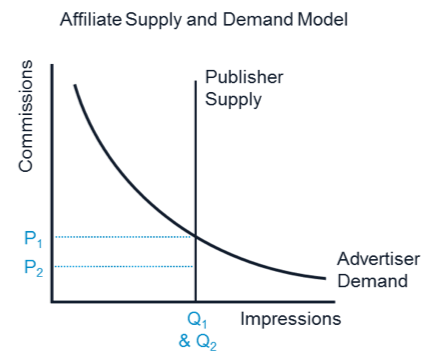Affiliate economics: Why supply and demand fails for affiliates
4 Apr, 2019
Written by
Owen Hancock, Head of Strategy, Europe, CJ Affiliate
I love the affiliate industry and the people in it. Their drive and creativity are part of what has kept me working in this channel for the last eight years. But there’s a phrase I hear a lot in our industry which doesn’t sit right with me...
‘I’m not being paid fairly for the sales I drive’.
The reason it gets under my skin is not that I think publishers shouldn’t be paid more, nor because I think people are complaining unduly.
It’s because I’m worried that fairness is coming into it at all.
I have a background in economics, and economics tells me that when you work in a free market, supply and demand sets the price. If publishers have valuable advertising space on their sites - which they do - and advertisers want to pay for that space - which they do - then where these factors meet should set the right price for that exposure.
 Market forces set price.
Market forces set price.
How should the price be set?
So the cost per acquisition (CPA) an affiliate gets paid should be based on how much the advertiser wants that exposure opportunity - demand - and how many opportunities that publisher, or similar publishers have - supply.
If demand is very high, with lots of advertisers competing for that space, you’ll get a high price. If supply is limited with only a handful of exposure opportunities, the price will be high as well. But if you have much supply, e.g. a new merchant can be popped on site with minimal effort or loss of traffic to other advertisers – then the price will be low.

Compare a magazine site such as SheerLuxe who can demand high integration fees for appearing on site as opposed to a typical voucher site who will add most advertisers for free.
What isn’t working?
The fundamental problem is that publishers cannot limit quantity when advertisers reduce the price (i.e. the CPA). It works fine for paid search – lower bids mean fewer ads, same for display in the main part. Even in affiliate, this is fine for tenancies or exposure increases – if the advertiser won’t pay for a newsletter inclusion, you can include advertiser who will.
But for regular, on-site inclusion with a CPA attached to it – a publisher only has a binary choice with the quantity of exposure.
Either leave the merchant on site or take them off. 100% of quantity, or 0%.
Why is this a problem?
This leaves advertisers able to make ongoing commission reductions without feeling the effect.
Zero commissions for existing customers; not paying for cross-device transactions or ITP affected sales; not paying for in-app sales... these behind the scenes - maybe even unconscious - cuts are happening.
But if we’re saying fairness shouldn’t come into it, what’s the problem with this?
The problem is that eventually, the supply will change. There’s a lag, a long one, between changes in commissionable sales and the quantity of exposure available in the affiliate ecosystem.
But there is a connection.
If you reduce the volume money flowing into the affiliate channel, then you will see fewer and fewer new entrants into the space, and this will be felt most keenly in the long tail.
The bloggers will dry up or turn to other (less accountable) channels to fund themselves. The larger publisher too will have less funding for innovation and finding new ways to drive value in the channel.
In reality, we’ve already been drying up our long tail by making it challenging to earn commission. This can be seen in dramatic challenges many programmes face with publisher diversity.
What do we need to do?
Stop cutting commissions.
We must commission more, and commission on more sales. It’s scary, but it will be in the long-term best interest. It’s most intimidating because when you do this, you won’t see an immediate uplift in revenue.
Efficiency for that quarter won’t look as good as it did. It may not look as strong for a year. But eventually, you will see an increase in quantity and revenue from the channel.
Those advertisers that stay the course will reap those benefits of revenue growth and publisher diversity in years to come. Those that don’t will struggle.
Expand Your Brand’s Reach
Achieve sustained growth and reach your target audience. Work with world-class publishers and influencers to successfully promote brand products and services.
Partner with the World’s Best Brands
Earn seamlessly by partnering with the world’s most widely recognised brands, promoting products and services your audience enjoys. Engage with brands you know and love all in one place.
Share